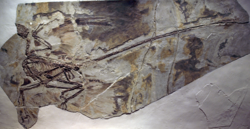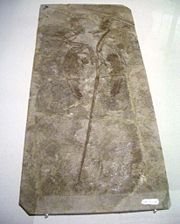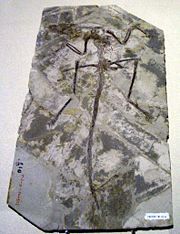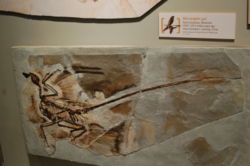Microraptor
2008/9 Schools Wikipedia Selection. Related subjects: Dinosaurs
| Microraptor Fossil range: Early Cretaceous |
||||||||||||||||||
|---|---|---|---|---|---|---|---|---|---|---|---|---|---|---|---|---|---|---|
 Cast of the holotype specimen of Microraptor gui.
|
||||||||||||||||||
| Scientific classification | ||||||||||||||||||
|
||||||||||||||||||
| Species | ||||||||||||||||||
|
Microraptor ("small thief") is a genus of small, dromaeosaurid dinosaur. About two dozen well-preserved fossil specimens have been recovered from Liaoning, China. They date from the early Cretaceous Period ( Barremian stage), 130-125.5 million years ago. Two species have been named, M. zhaoianus and M. gui. It has recently been suggested that all of the specimens belong to a single species, which is properly called M. zhaoianus. Cryptovolans, another four-winged dromaeosaur, may also be a species of Microraptor.
Like Archaeopteryx, Microraptor provides important evidence about the evolutionary relationship between birds and dinosaurs. Microraptor had long pennaceous feathers that form wing-like surfaces on the arms and tail but also, surprisingly, on the legs. This led Xu (2003) to describe it as a "four winged dinosaur", and to speculate that it may have glided using all four limbs for lift.
Description
At 55-77 centimeters (1.8-2.5 ft) long from its nose to the tip of its tail, Microraptor was among the smallest known dinosaurs. Aside from its extremely small size, Microraptor was among the first non-avian dinosaurs discovered with the impressions of feathers and wings. Three specimens of M. zhaoianus have been described in detail, in addition to six specimens of M. gui described by Xu et al. in 2003, from which most feather impressions are known. Unusual even among early birds and feathered dinosaurs, Microraptor is one of the few known bird precursors to sport long flight feathers on its feet as well as its forearms and hands. Their bodies had a thick covering of feathers, with a diamond-shaped fan on the end of the tail (possibly for added stability during flight). Xu et al. (2003) compared the longer plumes on Microraptor's head to those of the Philippine Eagle. Bands of dark and light present on some specimens may indicate colour patterns present in life. Several anatomical features found in Microraptor, such as a combination of unserrated and partially serrated teeth with constricted 'waists', and unusually long upper arm bones, are shared with both primitive avians and primitive troodontids. Microraptor is particularly similar to the basal troodontid Sinovenator; in their 2002 description of two M. zhaoianus specimens, Hwang et al. note that this is not particularly surprising, given that both Microraptor and Sinovenator are very primitive members of two closely related groups, and both are close to the deinonychosaurian split between dromaeosaurids and troodontids.
Paleobiology
Wings
Microraptor had two sets of wings, on both its fore- and hind legs (close studies of the Berlin specimen of the primitive bird Archaeopteryx show that it too, had flight feathers on its hind legs, albeit shortened).. The long feathers on the legs of Microraptor were true flight feathers as seen in modern birds, with asymmetrical vanes on the arm, leg, and tail feathers. As in bird wings, Microraptor had both primary (anchored to the hand) and secondary (anchored to the arm) flight feathers. This standard wing pattern was mirrored on the hind legs, with flight feathers anchored to the upper foot bones as well as the upper and lower leg. It had been proposed by Chinese scientists that the animal glided, and probably lived in trees, pointing to the fact that wings anchored to the feet of Microraptor would have hindered their ability to run on the ground, and suggest that all primitive dromaeosaurids may have been arboreal.
Sankar Chatterjee determined in 2005 that, in order for the creature to glide or fly, the wings must have been split-level (like a biplane) and not overlayed (like a dragonfly), and that the latter posture would have been anatomically impossible. Using this biplane model, Chatterjee was able to calculate possible methods of gliding, and determined that Microraptor most likely employed a phugoid style of gliding--launching itself from a perch, the animal would have swooped downward in a deep 'U' shaped curve and then lifted again to land on another tree. The feathers not directly employed in the biplane wing structure, like those on the tibia and the tail, could have been used to control drag and alter the flight path, trajectory, etc. The orientation of the hind wings would also have helped the animal control its gliding flight. Chatterjee also used computer algorithms that test animal flight capacity to test whether or not Microraptor was capable of true, powered flight, in addition to passive gliding. The resulting data showed that Microraptor did have the requirements to sustain level powered flight, so it is theoretically possible that the animal flew on occasion in addition to gliding.
Ground movement
Some paleontologists have suggested that feathered dinosaurs used their wings to parachute from trees, possibly in order to attack or ambush prey on the ground, as a precursor to gliding or true flight. In their 2007 study, Chatterjee and Templin tested this hypothesis as well, and found that the combined wing surface of Microraptor was too narrow to successfully parachute to the ground without injury from any significant height. However, the authors did leave open the possibility that Microraptor could have parachuted short distances, as between closely spaced tree branches.
Chatterjee and Templin also ruled out the possibility of a ground-based takeoff. Microraptor lacked the necessary adaptations in its shoulder joint to lift its front wings high enough vertically to generate lift from the ground, and the authors argued that a ground-based takeoff would have damaged flight feathers on the feet. This leaves only the possibility of launching from an elevated perch, and the authors noted that even modern birds do not need to use excess power when launching from trees, but use the downward-swooping technique they found in Microraptor.
Implications
The unique wing arrangement found in Microraptor raised the question of its importance to the origin of flight in modern birds--did avian flight go through a four-winged stage, or were four-winged gliders like Microraptor an evolutionary side-branch that did not leave descendants? As early as 1915, some scientists had argued that the evolution of bird flight may have gone through a four-winged (or tetrapteryx) stage. Chatterjee and Templin did not take a strong stance on this possibility, noting that both a conventional interpretation and a tetrapteryx stage are equally possible. However, based on the presence of unusually long leg feathers in various feathered dinosaurs, Archaeopteryx, and some modern birds such as raptors, as well as the discovery of Pedopenna (another dinosaur with long primary feathers on its feet), the authors argued that the current body of evidence, both from morphology and phylogeny, suggests that bird flight did shift at some point from shared limb dominance to front-limb dominance, and that all modern birds may have evolved from four-winged ancestors, or at least ancestors with unusually long leg feathers relative to the modern configuration.
Naming
The naming of Microraptor is controversial, because of the unusual circumstances of its first description. The first specimen to be described was part of a chimeric specimen — a patchwork of unrelated feathered dinosaur species assembled from multiple specimens in China and smuggled to the USA for sale. After the forgery was revealed by Xu Xing of Beijing's Institute of Vertebrate Paleontology and Paleoanthropology, Storrs L. Olson, curator of birds in the National Museum of Natural History of the Smithsonian Institution, published a description of the tail in an obscure journal, giving it the name Archaeoraptor liaoningensis in an attempt to remove the name from the paleornithological record by assigning it to the part least likely to be a bird. However, Xu had discovered the remainder of the specimen from which the tail had been taken and published a description of it later that year, giving it the name Microraptor zhaoianus.
Since the two names designate the same individual as the type specimen, Microraptor zhaoianus is a junior objective synonym of Archaeoraptor liaoningensis and the latter, if valid, has priority. So, according to some interpretations of the International Code of Zoological Nomenclature, the valid name for this dinosaur probably is Archaeoraptor liaoningensis Olson 2000. However, there is some doubt whether Olson in fact succeeded in meeting all the formal requirements for establishing a new taxon. Most paleontologists are unwilling to use the name Archaeoraptor regardless of the precise legal status of the name. This is firstly because that name is strongly associated with the fraud and the National Geographic scandal and secondly because they view Olson's use of the name as attempted nomenclatural sabotage and do not want to support it. The name Microraptor zhaoianus Xu et al., 2000 has therefore almost attained universal currency.
Species list
So far, six virtually complete skeletons of Microraptor have been found in Liaoning, China in 2001 and 2002.
- Family: Dromaeosauridae
- Clade Microraptoria
- Genus: Microraptor
- Microraptor zhaoianus
- Microraptor gui
- Genus: Microraptor
- Clade Microraptoria
Note: Cryptovolans pauli, which has the same four-wing body plan as M. gui, may also be a species of Microraptor. Senter et al. 2004 found that M. zhaoianus, M. gui, and C. pauli are all the same species (M. zhaoianus).
In popular culture
- Microraptor featured prominently in the third episode of the 2006 mockumentary television series Prehistoric Park. In the episode, Microraptor were shown flocking down from trees to feast on worms and insects that were brought to the surface by the passage of giant titanosaurs.
- A Microraptor gui named Guido appeared in the animated film The Land Before Time XII: The Great Day of the Flyers.
- In the book Dinotopia: Journey to Chandara, the Chandaran Empire, comprising the southeastern portion of the island of Dinotopia, is ruled by the microraptor Emperor Hugo Khan.
- A Microraptor model was introduced into the Carnegie Collection in 2006.


